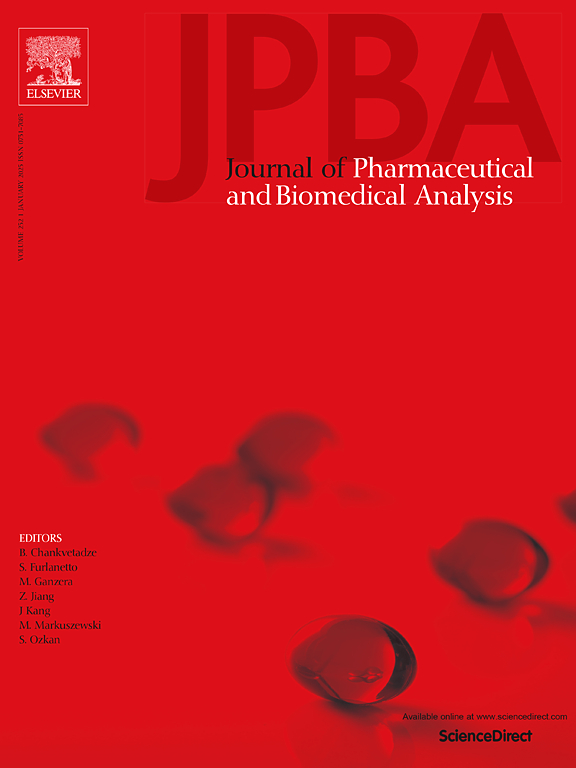快速诊断地奎特和百草枯中毒:胶体金免疫层析和亲水性相互作用液相层析的双重方法
IF 3.1
3区 医学
Q2 CHEMISTRY, ANALYTICAL
Journal of pharmaceutical and biomedical analysis
Pub Date : 2025-04-25
DOI:10.1016/j.jpba.2025.116923
引用次数: 0
摘要
对中毒病例的准确诊断和治疗需要监测双菊酯和百草枯的浓度。本研究提出了一种竞争性胶体金免疫层析测定(GICA)条进行定性检测,并与亲水相互作用紫外检测液相色谱(HILIC-UV)进行定量评估。两种方法都经过了严格的验证。GICA条的检出限为20 ng/mL,与加标血清样品中的草甘膦、溴氰菊酯或敌敌畏无交叉反应性。100% %的符合率证实了其重复性,在浓度为200 ng/mL的10个质量控制样品中进行了验证。HILIC-UV检测限为0.2 μg/mL,在0.2 ~ 6.4 μg/mL范围内呈良好的线性关系(r²>;0.99)。准确度范围为86.4 % ~ 111.4 %,相对标准偏差(RSD)小于10.8 %。质控样品的Sigma指标为4.47 ~ 6.09,建立1 - 3 s/ 2/3-2 s/ r -4s内部质控方案(n = 3,r = 1)。共24例患者标本采用HILIC-UV和GICA条进行双重检测。其中,来自17名患者的21份样本检测呈阳性,而确认草甘膦、溴氰菊酯和敌敌畏中毒的3名患者检测呈阴性,表明完全一致。阳性结果中,11例诊断为百草枯中毒,6例诊断为双喹菊酯中毒,均明显损害肝、肾和凝血功能。将用于快速定性评估的GICA与用于定量分析的HILIC-UV相结合,增强了对diquat和百草枯中毒的识别,使其特别适用于紧急诊断。本文章由计算机程序翻译,如有差异,请以英文原文为准。
Rapid diagnosis of diquat and paraquat poisoning: A dual approach using colloidal gold immunochromatographic assay and hydrophilic interaction liquid chromatography
Accurate diagnosis and treatment in poisoning cases necessitate the monitoring of diquat and paraquat concentrations. This study presents a competitive colloidal gold immunochromatographic assay (GICA) strip for qualitative detection, alongside hydrophilic interaction liquid chromatography with ultraviolet detection (HILIC-UV) for quantitative assessment. Both methods underwent rigorous validation. The GICA strip achieved a detection limit of 20 ng/mL and demonstrated no cross-reactivity with glyphosate, deltamethrin, or dichlorvos in spiked serum samples. A compliance rate of 100 % confirmed its repeatability, validated by ten quality control samples at a concentration of 200 ng/mL. HILIC-UV exhibited a detection limit of 0.2 μg/mL and excellent linearity for paraquat and diquat in serum and urine across a range of 0.2–6.4 μg/mL (r² > 0.99). Accuracy ranged from 86.4 % to 111.4 %, with relative standard deviation (RSD) below 10.8 %. Sigma metrics for quality control samples varied from 4.47 to 6.09, establishing a 1–3 s/2/3–2 s/R-4s internal quality control scheme (n = 3, r = 1). A total of 24 patient specimens were subjected to dual testing with HILIC-UV and GICA strips. Among these, 21 samples from 17 patients tested positive, while three patients with confirmed glyphosate, deltamethrin, and dichlorvos poisoning tested negative, indicating complete consistency. Of the positive results, 11 patients were diagnosed with paraquat poisoning, and six with diquat poisoning, both of which significantly impair liver, kidney, and coagulation functions. Integrating GICA for rapid qualitative assessment with HILIC-UV for quantitative analysis enhances the identification of diquat and paraquat poisoning, making it particularly suitable for emergency diagnostics.
求助全文
通过发布文献求助,成功后即可免费获取论文全文。
去求助
来源期刊
CiteScore
6.70
自引率
5.90%
发文量
588
审稿时长
37 days
期刊介绍:
This journal is an international medium directed towards the needs of academic, clinical, government and industrial analysis by publishing original research reports and critical reviews on pharmaceutical and biomedical analysis. It covers the interdisciplinary aspects of analysis in the pharmaceutical, biomedical and clinical sciences, including developments in analytical methodology, instrumentation, computation and interpretation. Submissions on novel applications focusing on drug purity and stability studies, pharmacokinetics, therapeutic monitoring, metabolic profiling; drug-related aspects of analytical biochemistry and forensic toxicology; quality assurance in the pharmaceutical industry are also welcome.
Studies from areas of well established and poorly selective methods, such as UV-VIS spectrophotometry (including derivative and multi-wavelength measurements), basic electroanalytical (potentiometric, polarographic and voltammetric) methods, fluorimetry, flow-injection analysis, etc. are accepted for publication in exceptional cases only, if a unique and substantial advantage over presently known systems is demonstrated. The same applies to the assay of simple drug formulations by any kind of methods and the determination of drugs in biological samples based merely on spiked samples. Drug purity/stability studies should contain information on the structure elucidation of the impurities/degradants.

 求助内容:
求助内容: 应助结果提醒方式:
应助结果提醒方式:


